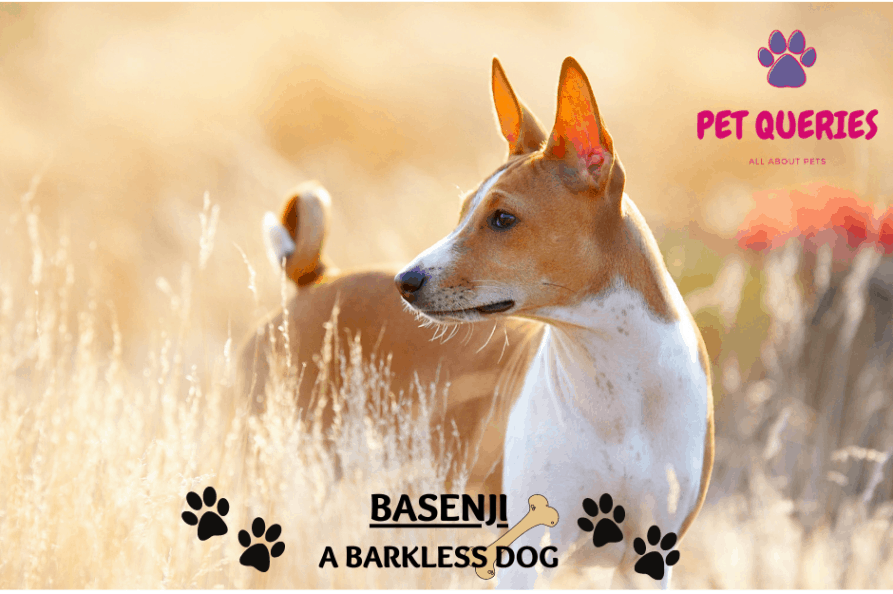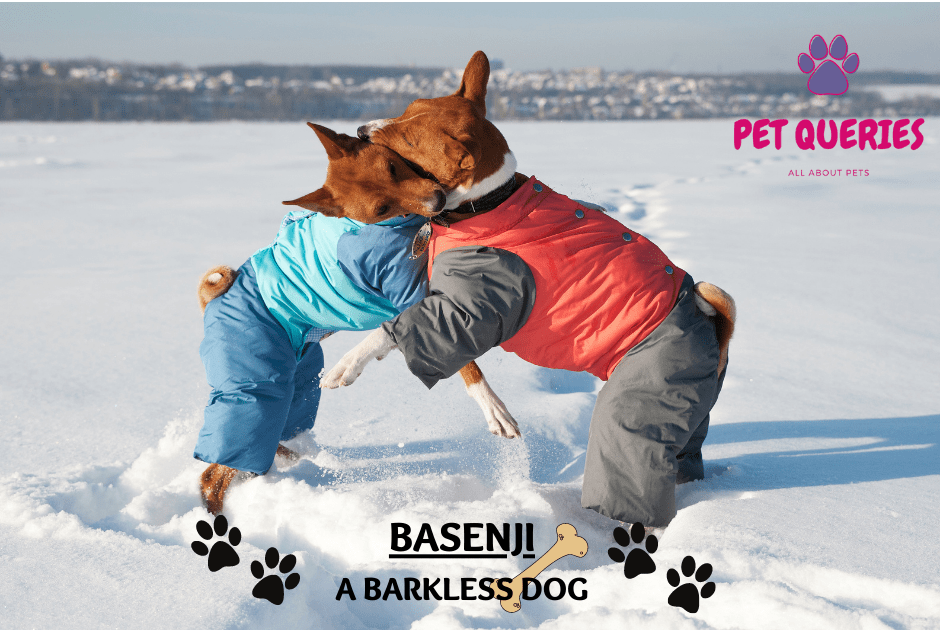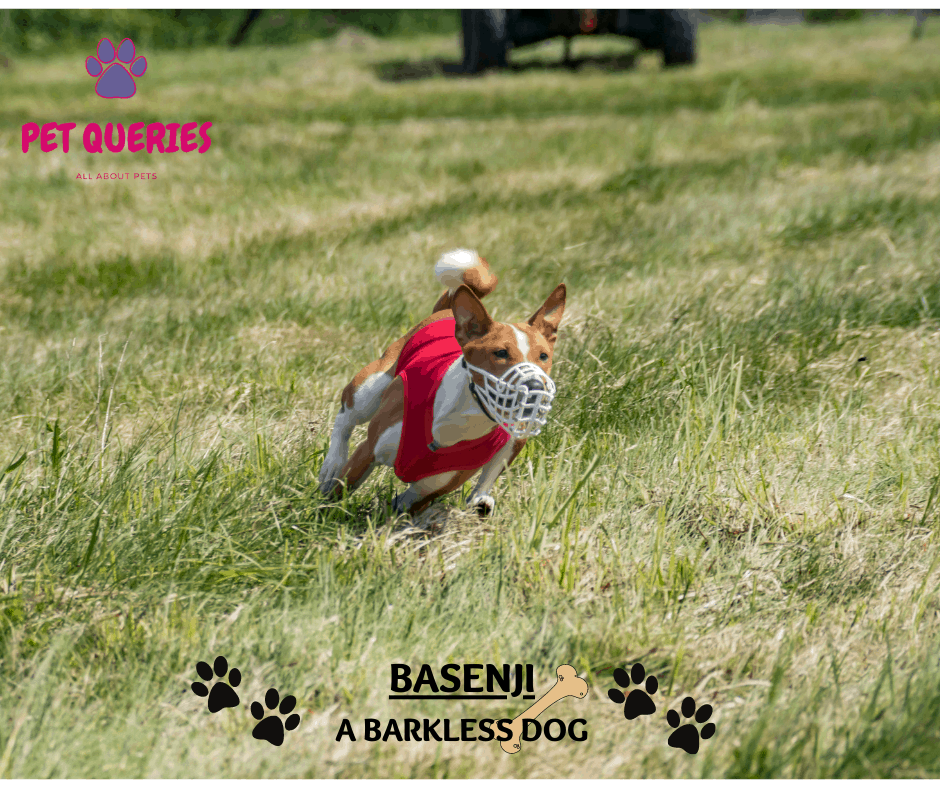
| HEIGHT | 15-17 inches |
| WEIGHT | 22-24 pounds |
| LIFE EXPECTANCY | 12-16 years |
| COLOURS | Black & White, Black, Brindle, Tan, Tri-colour, Red |
| HYPOALLERGIC | Yes |
| TEMPERMENT | Intelligent, Energetic, Curious, Playful, Affectionate and Protective |
| APPEARANCE | Small, Short haired, Curled tails, Erected ears and Graceful neck. |
| SHEDDING | Low |
| ENERGY LEVEL | High |
| COST | 1200$ – 1450$ |
Table of Contents
Basenji breed
Basenji dog is a unique breed that originated from local dogs of Congo. It is a hunting breed dog that cannot bark. They produce an unusual sound because of its differently shaped larynx. Basenji has many other names like African bush dog, African Barkless dog, Congo Dog, Zande dog, and Ango angari. They are very active and energetic dogs and usually kept for active hunting or playing.
Appearance
Basenji dogs appear to be small and short with erected ears. They may not bark but has good physic and looks crookedly powerful.
In general, they grow about 16-17 inches of height; typically, the male would be of 16-17 inches, and females would be of 15-16 inches.
The average weight of male dogs are 22-26 pounds, and females weigh about 19-25 pounds.
You can say the basenji size ratio is similar to that of height and length and good grounded jumpy legs like suspension hold. They make us of the tail while they pace up high speeds and also athletic dogs by innate. It loves to wander here and there quickly with high energy.
These basenji dogs appear to be mostly in mixed hues like red and dark, white and orange, Black and brindle, and sometimes tricolor. Chest, tail sharps, and feet mostly come up white in color.
Grooming and Shedding
Well, Basenji comes under moderate shedding dog, but their rate of shedding changes with the season.
Shedding is low in spring, whereas high in autumn; this happens according to the body’s reactions to tolerate heat and cold.
Excess growth of hair turns up to resist cold, and shedding occurs, vice versa in a hot climate, less growth of hair keeps them tolerant.
So, throughout the year, a pet owner can invest less effort in grooming and shedding of Basenji. Also, similar to that of cats, basenji grooms itself by licking most of the time.
But if you want to groom by your hands to your pooch then just follow some tips,
- Use a soft brush or cloth to wipe them throughout the body.
- Regular grooming is not necessary; only once or twice a week is appreciated.
- Gradually make your dog get habituated and offer treats as well if needed so that it tunes up with you, and this habit saves you from cleaning up hair all along the floor.
- Wear a hand glove and grooming mitt before you start.
- Always use the hygiene gloves to avoid them from allergies.
- Ask your vet for better recommendations to maintain the coat in the top end state.
- Trim up nails at regular intervals.

Bathing
Basenji does not require a frequent bathing lifestyle. Once in a month or two would be great for them unless your dog stays or plays out most of the time.
The puppy should not be dropped off into water until it gets 5 to 6 months old and suggested by your vet doc as it is the phase of vaccine and many injections going in, making reactions.
Careful and sensitive shampoos are to be selected as per the veterinarian advice. Unless suggested, do not use any kind of medicated shampoo for basenji dogs.
Waterless shampoo can be used if the dog smells odd; this will avoid contact with water. Some shampoo would be helpful in managing your hypoallergenic dog as well.
So, bathing is to be done under careful circumstances and make use of wet and dry cloth to feel them gentle and comfortable before you directly pour or spray water on to them.
Temperament
These dogs are very energetic, dominant, and playful. They show much affection towards pet owners and too protective about them. Basenji dogs are good at activities and act intelligently as well.
Their solid physic requires a good amount of exercise and attention. Basenji would lead to destruction if they are not fit and under-exercised, so keeping them engaged is a must and should.
When matured, your dog would turn up doing odd stuff and behaves weirdly. Remember, this is common, and much of your attention would make them feel better.
Their innate bossy behavior makes them feel independent and willful, which in turn appears to be fearful despite barklessness. They just make the yodeling sound, unlike the other dogs.

Exercise Requirements
The most important thing a Basenji pet owner has to address is their exercise requirements. They are the breeds of hunting dogs possessing high levels of stamina.
In order to keep them up high, a regular stretch of exercise is mandatory. If not, they misuse their energy investing in destruction. Two slots of exercising for about 30 min in a day is the best fit for basenji dogs.
To keep them engaged, exercises, or activities like jumping, jogging, hill climbing, and racing should be encouraged. People who love adventures like trekking can get a good company with these dogs.
Health issues
Like many dogs, basenji dogs are also prone to bacterial and viral infections. Before you consider basenji as a pet, you must be aware of certain health conditions to which basenji dogs are exposed to. You can find some issues listed below,
Parasites
A wide range of worms and bugs are infectious to your dog’s similar to that of humans. They may attack your feline friend and invade your barkless African dog all around. It causes severe agony to your pet and may even spread to you and your family through them.
So, keen observation and regular check-ups are recommended. Preventive vaccines or medicines are compulsory for dogs to keep them safer. Once dogs get affected badly because of this parasite may discomfort them and lead to death, it depends on severity.
Obesity:
Obesity is a critical health issue in basenji dogs and can cause digestive disorders, worsen joint pains, back pain, and heart diseases. Dogs suffering from obesity can be easily identified as overweight, about 20% more than the ideal body weight.
If your dog is suffering from obesity, then it may suffer from the following risks:
- Urinary bladder stones
- Anesthetic complications
- Cancer
- Diabetes mellitus
- Hypertension
- Osteoarthritis
Hip and elbow dysplasia:
Dysplasia is a type of disease that can cause improper or incompletely formed joints in your canine.
In basenji dogs, hip and elbow dysplasia is the most common disease, and the improper joints are mostly formed by arthritis. Dogs suffering from this will have a problem in stiffness as he becomes mature.
In this condition, they can suffer from pain, and it will be difficult for them while lying down and getting up. But we cannot see any discomfort In their body while they are walking or running. You should be aware of this condition before owning a pup.

Knee problems:
Basenjis may suffer from patellar luxation, which means the dogs kneecap may slip out of its place.
If your canine has this problem at a mild level, then there is no need to worry, but if it is in severe condition, your pup may need surgery.
You may observe this condition in your pup while running; suddenly, it skips and hops for a few strides and can easily pop the kneecap back in place.
Eye problems:
Basenjis may suffer from progressive retinal atrophy (PRA). It is a genetic problem in the eyes from which your pup can go blind. While compared to other dog’s, Basenjis are the most affected by this disease.
Basenjis are the most unfortunate dogs in this issue; they can develop many different eye problems, and some of them even cause them to complete blindness. You should consult a vet immediately in this condition, and proper treatment is necessary for your pup.
Basenjis cause small white crystal dystrophy on the cornea layers, which is the dog’s eye’s outer layer.
Mange:
In this case, your dog can cause dry, irritated, and hairless lesions. It is a microscopic mite that lives in the hair of the dogs. This issue in dogs is developed if the dogs’ immune system goes down, so you should keep your dog’s immune system good. Basenjis can develop over many mites, often causing them to be itching mostly on the face or feet. Sometimes it may not be itchy, depends on the bred. If it is not controlled, you have to manage It throughout life, so consulting a vet is very important in this case as soon as possible.
Epilepsy:
Three types of seizures are present in this condition: primary, secondary, and reactive. In reactive seizures, dogs can cause metabolic problems such as organ failure and blood sugar. When it comes to secondary seizures, the issues are tumor stroke or trauma, and in the primary seizures, there won’t be any causes that are called idiopathic epilepsy.
This problem is common in your barkless dog. If your dog suffers from these seizures, you can see the symptoms from six months and develop the issue upto three years of age.
Diet and care guide:
For a healthier life, your basenji should follow a proper food diet. The diet and exercise routine is essential for your canine.
Follow the following things for a perfect diet and care:
- Basenji, the barkless dogs, are considered the less shedding dogs, so brush their coat when needed, but brushing once in a week will keep it clean, neat, and good-looking.
- Brush your dog’s teeth twice a week.
- Keep things away from the dog, which is not good for their health. Keep your canine with you every time, if possible and keep the doors closed; this will help your dog maintain discipline and keep the objects away from it, which it should not eat or chew or keep in mouth.
- Diet for a basenji should be maintained depending on the age of the pup. A good diet is recommended for their well being.
- Basenjis are very active dogs, so exercise them regularly; this will keep them fit. Newborn Basenjis may get tired quickly when doing exercise, so play with them according to their age.
- A tall fence is required outside of your balcony as the Basenjis can jump high, and they chase small animals, so be with them every time.
- Clean the ears of Basenjis neatly while bathing
- Don’t overfeed your basenji.
- Feeding food like pork, chicken, beef, or fish bones are not recommended.
- Feed your young puppies at least 2 to 3 times a day
Toxic foods:
You can’t feed every human food for dogs. The toxic level of the food should be verified before feeding it to your canine.
Here we have listed some of the toxic foods which are not recommended for your basenji dog:
- Chocolates
- Corns
- Cooked bones
- Onions
- Garlic
- Chives
- Alcohol
- Artificial sweetener
- Grapes
- Cherries
- Seeds
- Potatoes
- Mushrooms
- Broccoli
Non-Toxic foods which are not recommended for Basenjis:
- Apples
- Bananas
- Blueberries
- Cantaloupe
- Cucumbers
- Mangoes
- Peaches
- Celery
- Sprouts
- Watermelons
- Pineapples
- Pears
When is the right time for spaying or neutering the Basenji’s?
First, let’s know what spaying and neutering are exactly about. Spaying means removing reproductive organs like ovaries and uterus from the female dog following a procedure of incision in the abdomen.
Whereas, Neutering is the removal of the testis from male dogs. This is done in basenji, usually at the age of four months to nine months. This spaying or neutering is done at the time of puberty and believed that there are long term health benefits and decreases their aggression.
Spaying or neutering is not mandatory in basenji but is recommended, which can make you see a happy and healthy dog. It is also proven that spaying or neutering in basenji can reduce the risks of testicular cancer, breast cancer, and some uterine infections as well.
There are no dangers of having this done, and not painful too for your pup. Even this surgery is not so complicated as any other.
Are Basenji good family dogs?
Basenjis are well suited as a family dog. Families that need calm, energetic dogs with a very protective nature can adopt these dogs as Basenjis are barkless dogs; they are not disturbing for your neighbors.

Adding to this, Basenjis are a very smart, loyal, and playful dog. If proper training and socialization were given to them, your pup would turn up so good and cherish having them as a pet.
The only constraint is they need attention and should exercise them regularly. So, families who don’t have much time to invest in their pet can avoid basenji dog.
Are Basenji dogs good with kids?
Basenjis are good with kids, but training is a must and should, to let them know how to treat kids. There is a danger of basenjis assuming babies as their own and start treating as their kind in terms of aggression and barking. So, always have keen supervision of your kids in basenji presence, but we would say that young kids can have a good company as they are playful dogs with lots of energy.
Are Basenji dogs good for busy families?
Basenjis are not so recommended for busy families. They are energetic and have compulsory exercise requirements for them.
If time is not invested in them at all, they will misuse their energy, and you see them using it in destruction. Before that, we already know that their ancestors are known for hunting, so regular engagement in the critical workout is essential.
Though they are very affectionate, loyal, and protective, they cannot be left alone for a long time. They require attention, good socialization, and proper training, which is impossible for busy families to take over.
Are Basenji dogs good for the apartment lifestyle?
Basenjis are known for their energetic and playful nature. They require a big place for them to roam or run around freely, which is problematic in an apartment lifestyle but can be manageable if taken to dog parks if available.
They are barkless dogs, which makes no sound and less disturbance for their neighbors. The way you train and socialize basenji also make them adapt and adjust to the apartment living lifestyle.
They are not diggers as well, creating no problem for pet owners, but the only thing is the danger of destruction; that is when basenji misuse the energy instead of exercising that would make a mess around.
So, regular investment of time on them, dealing with exercises, training, and socialization would be appreciated.
